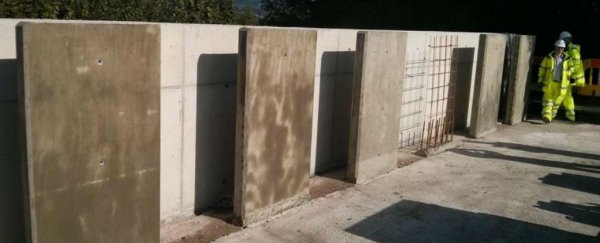The concept of self-healing concrete doesn't sound too exciting, until you think about all the pavement cracks and road potholes that we have to put up with on a daily basis. Maintaining the infrastructure of a modern, developed nation costs a huge amount of time and money, and having bridges and buildings take care of their own repairs would free up resources to use elsewhere.
Now trials are underway in Wales to see if self-healing concrete is a viable option for the country's network of roads, towns, and cities. Three different technologies are being tested as part of the Materials For Life (M4L) project, and it's hoped that they might eventually be combined into one super-tough mixture. The materials involved would be embedded into the concrete as it was made, and they'd be able to detect and fix problems autonomously.
Representatives from industry experts, Costain, are working alongside academics from several UK universities as the study gets underway. Six concrete walls are going to be cracked and broken as necessary before the self-healing technologies are left to do their work.
The first technique involves shape-memory polymers - special materials that are able to transform their shape when heated to return to a preconfigured layout. The second technique uses a network of thin tunnels in the concrete to pump through both organic and inorganic healing agents. The third method involves tiny capsules of bacteria and healing agents embedded inside the concrete: these capsules produce calcium carbonate, which should theoretically be able to close up cracks.
Those are the hypotheses, and now they're about to be put to the test: once the scientists see the materials in action, they'll have a better understanding of how they could work at a larger scale. It's estimated that around £40 billion (US61 billion) is spent each year in the UK on structure maintenance, and the majority of these structures are made of concrete.
"Our vision is to create sustainable and resilient systems that continually monitor, regulate, adapt and repair themselves without the need for human intervention," said engineer Bob Lark from the University of Cardiff. "These self-healing materials and intelligent structures will significantly enhance durability, improve safety and reduce the extremely high maintenance costs that are spent each year. This major trial, the first of its kind in the UK, will provide us with important insights to help transfer the technologies from the lab into real-world settings."
With self-healing and water-absorbing concrete on the way, the cities of the future should be much better equipped to take care of themselves - which means we'll have to spend less time reporting potholes to the council.
